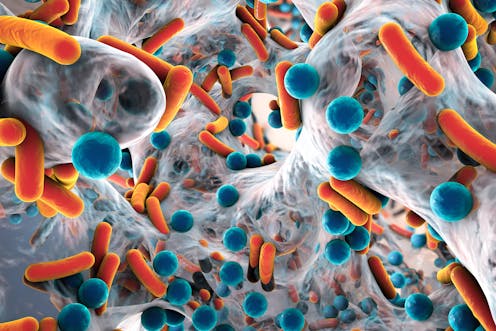New gene transfer rules could help prevent spread of antibiotic resistance
- Written by Heather Hendrickson, Senior Lecturer in Molecular Bioscience, Massey University

Unlike other organisms, bacteria can take up genetic material from their environment. This ability to exchange genes enables them to pick up new traits such as different metabolic pathways, virulence genes and antibiotic resistance.
Better understanding of the complex mechanisms of gene transfer may be the key for holding the line against the global threat of increasing antibiotic resistance. Our latest findings have taken us step closer to this goal by uncovering a new set of rules.
Read more: Antibiotics before birth and in early life can affect long-term health
Bacterial genomes doing what we cannot
Bacteria are our constant and ubiquitous companions. Teeming throngs of bacteria shimmy around on every surface and their collective biomass is more than a thousand times bigger than that of the entire human population.
We would not survive for long without bacteria. We owe them for making our planet habitable and for their role in returning nutrients to the soil. Earth without microbes is a nightmare scenario. However, the evolutionary processes that allow bacteria to survive in conditions that are off limits to other lifeforms can also make them detrimental to human health.
Read more: Why are some _E. coli_ deadly while others live peacefully within our bodies?
Unlike the human genome, which remains relatively unadulterated during our lifetimes, bacteria acquire new genetic material frequently. Some of the bacteria around you have changed since you began reading this.
While our own genetic material is tucked away behind the protective membranes of a nucleus, bacteria have no such vault-like structure. A single bacterium can have acquired as much as 60% of its genome recently through a phenomenon called horizontal gene transfer (HGT), where large swaths of DNA can be swapped in or completely replaced in a single step.
The conundrum
The mystery around HGT is that the processes by which it chops and changes DNA seem at first glance to be haphazard, and yet HGT tends to take place most frequently between closely related species. Why?
Horizontal gene transfer can happen in a few different ways. Each of them boils down to a bit of DNA being introduced into the bacterial cell, right next to the cell’s own DNA, and being accidentally incorporated into the chromosome. Regardless of how the DNA ends up inside that cell, the introduced DNA can be included in the genome of the recipient cell. No gene appears to be immune.
If the story were simple, that would be it. The cell with the new DNA would face natural selection by competing for resources with other local microbes. If the DNA contained genes that are beneficial this might mean new abilities for the cell, like surviving the next local antibiotic apocalypse.
However, biology is rarely so simple. Rather, bacteria that are more closely related tend to give and receive genes more frequently than one might expect. Part of the reason that this is surprising is that the most likely candidates for donating genes in any environment are not close relatives. As many as 18,000 separate bacterial genomes can be found in a single gram of soil. This suggests that something other than proximity determines what gene transfer events are successful.
The rules
At the core of our work are short, repeated sequences called AIMS, or Architecture IMparting Sequences. AIMS are important during DNA replication and DNA segregation in bacteria.
We discovered that if sets of AIMS are well matched between a donor and recipient genome, then the DNA moving between those genomes can be maintained. The opposite is true if they are not well matched, effectively establishing the “rules of transfer”.
In nature, incoming DNA rains down on a bacterial chromosome. The AIMS of a recipient cell act a bit like a holey umbrella that only lets AIMS compatible DNA through to be added to the chromosome. The patterns of inversions (random events in which a chunk of DNA is turned around to face the opposite direction) and HGT in bacterial chromosomes suggests that natural selection has filtered out the bacteria in which HGT with non-compatible AIMS had taken place.
It is worth mentioning that AIMS are not a hard barrier, but rather a constraint on HGT that positively enforces transfer between closely related organisms. While our results suggest that the wrong AIMS may cause problems for important systems like DNA replication and segregation, newly acquired genes that are game changers for the cell, like antibiotic resistance genes, are unlikely to be filtered out if they have incompatible AIMS. Like much in biology, AIMS based rules are another piece of a more complicated puzzle.
Making it work in our favour
Plasmids are tiny loops of double stranded DNA that float in the cell and are able to replicate independent of the bacterial chromosome. This makes them immune to AIMS associated constraints on gene transfer; they don’t have to enter the chromosome. They are one way that novel DNA can end up in the cell.
They are also often loaded with antibiotic resistance genes. If we can find ways of making these plasmids just a little more unbearable for the bacteria in the environment, perhaps we can limit their spread in the same way that AIMS limit transfer between bacterial chromosomes.
One idea would be a genetic tool that would force plasmids to physically integrate with chromosomes. This would simultaneously make these less mobile and subject them to the constraints that chromosomes function under. For example, a plasmid “immobilisation” cassette could be deployed in high-risk areas to reduce plasmid-based gene transfer in a group of multi-drug resistant disease-causing bacteria known as the ESKAPE pathogens.
If we can do that, perhaps in the future we can prevent the spread of genes we are worried about, like antibiotic resistance genes or virulence genes.
Authors: Heather Hendrickson, Senior Lecturer in Molecular Bioscience, Massey University



















